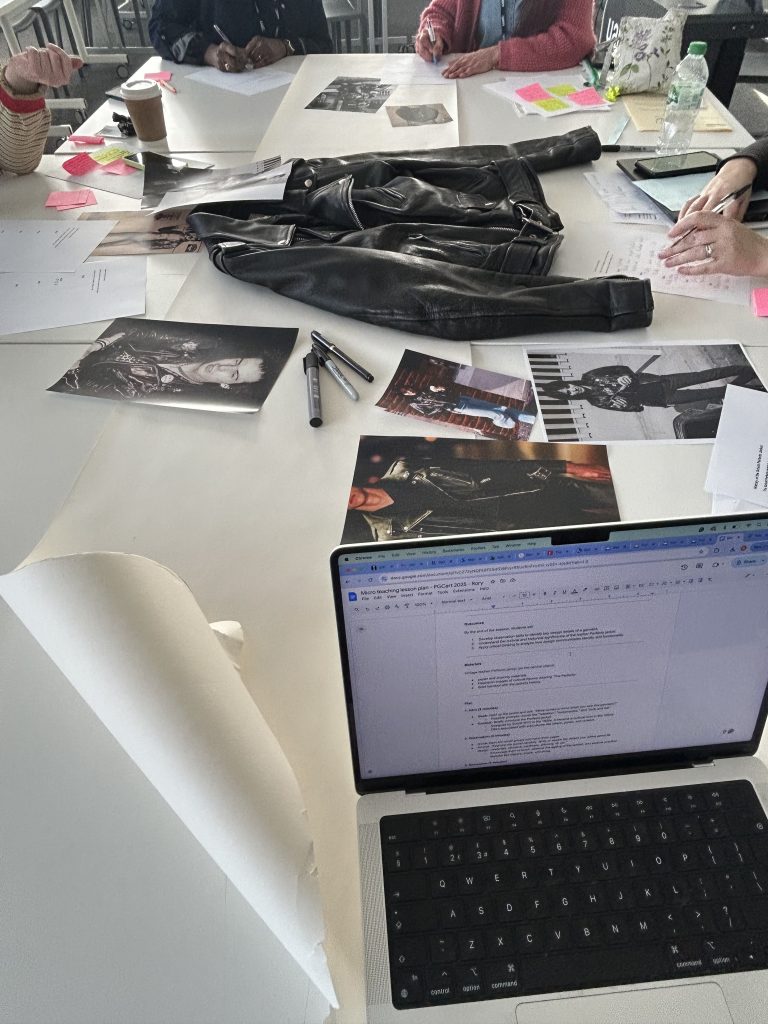Timed Pession Plan
20-Minute Micro-Teaching Session Plan: Object-Based Learning
Vintage Leather Perfecto Jacket
Exploring Design Details and Cultural Significance of a Vintage Leather Perfecto Jacket
Outcomes
By the end of the session, students will:
- Develop observation skills to identify key design details of a garment.
- Understand the cultural and historical significance of the leather Perfecto jacket.
- Apply critical thinking to analyse how design communicates identity and functionality.
Materials
Vintage leather Perfecto jacket (as the central object).
- paper and drawing materials.
- Research Images of cultural figures wearing ‘The Perfecto’.
- Brief handout with the jacket’s history.
Plan
1. Intro (3 minutes)
- Hook: Hold up the jacket and ask, “What comes to mind when you see this garment?”
- Possible prompts: words like “rebellion,” “motorcycles,” and “rock and roll.”
- Context: Briefly introduce the Perfecto jacket:
- Designed by Schott NYC in the 1920s, it became a cultural icon in the 1950s.
- Often associated with subcultures like bikers, punks, and rockers.
2. Observation (5 minutes)
- Divide them into small groups and hand them paper.
- Prompt: “Examine the jacket carefully. Write or sketch the details you notice about its design—materials, structure, hardware, stitching, fit, etc.”
- Encourage them to touch, observe the ageing of the leather, and explore practical features like zippers, snaps, and lining.
3. Discussion (5 minutes)
- Facilitate a discussion with the groups:
- “What do these design details tell us about the function of the jacket?” (e.g., protection for motorcycle riders, durability).
- “How might these details contribute to the cultural symbolism of the jacket?” (e.g., ruggedness, rebellion).
- Use images of cultural figures to illustrate how the jacket has been styled and adapted across different subcultures.
4. Reflection (5 minutes)
- Ask students:
- “If you were to reinterpret the Perfecto jacket for a modern collection, how might you change it to reflect today’s culture or trends?”
- “What could this jacket represent in a different cultural context?”
- Have groups share their ideas briefly.
5. Conclusion (2 minutes)
- Summarise key points:
- The Perfecto jacket’s balance of functionality and identity.
- How a single garment can hold cultural, historical, and design significance.
- End with a prompt for further thought: “Next time you design, think about how your garments might tell a story or become an icon like this one.”
Notes:
Observe engagement during the activity and discussion. Note how students connect design details to functionality and cultural context.
Description Of What Happened
In the micro-teaching sessions we were given a 20-minute slot to present an object-based learning experience for four peers, I presented a ‘Perfecto’ leather jacket which is a staple menswear wardrobe piece that originated in the late 1920s but was made popular in the 1950s with the prevalence of American motorcycle culture and later by a revival within subcultural moments of the 1970s and 1980s.
I wanted to foster a discussion around the multiple avenues that a single designed garment can take in terms of visual research and storytelling, the leather jacket is a good example of a garment that can be seen in subversive communities/queer communities as well as worn purely for the functional aspects of its design, it also sparks a conversation about sustainability, longevity and the moral implications of using animal products in design.
Key Decisions Made
I made the decision not to include the history of the garment in the initial group discussion, this was done because of reading I have been doing about building failure into projects, and because I want the journey to be open-ended and exploratory (especially at the beginning of a project). A student should feel as if there are no wrong answers in a session like this, and if they want to talk about the leather jacket that their father had that reminds them of home etc. that conversation should be facilitated, nostalgia and memory are important ideas to explore in research narratives, especially in fashion which is all about identity and storytelling.

The following questions were used on a prompt sheet but maybe could have been better to write on the roll of paper so that it was used in a more interactive way on the table, with students writing and drawing on this as a ‘sandbox’ space.
Examine the jacket carefully.
Write or sketch the details you notice about its design—
materials, structure, hardware, stitching, fit, etc.
What?
When?
Who?
How?
Why?
Feedback
Self-reflection
I think the session worked smoothly and the timing worked well as an introductory exercise, we could have delved deeper into deeper more probing questions perhaps, what do the functional aspects of the garment mean, are they still functional in a fashion context, does the garment itself create a dialogue with sexuality or is it the culture/subculture that have embraced the garment over the years that create this link, do they do this because of any elements of the garment itself, is leather inherently masculine/sexual etc.
There are lots of interesting conversations started but this object analysis style session, expoeiceally when the central object is a garment, working backwards from finished outcome back to research and back from research to your own personal manufactured outcome.
Leave a Reply